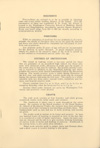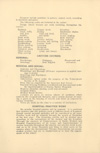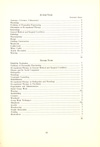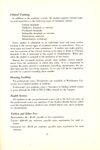Health Professions
The Progression of Occupational Therapy Training
The field of occupational therapy has evolved since its beginnings in the early 1900s. The changes are exemplified by the increasingly rigorous academic training required over the years. The following curriculums, from the occupational therapy programs associated with Washington University, provide a snapshot of the field’s evolution as a professional discipline within the medical care system.
The profession of occupational therapy grew out of the belief of the therapeutic power of occupation, that is, a meaningful way to use time. Early 20th-century physicians began to express the belief that people were healthier if they were meaningfully occupied. Occupation was recognized as both stimulating and concentrating the mind; manual work strengthened muscles and coordinated the body. Diversionary activity, exemplified by arts and crafts, was common in the first decades of OT practice.
The National Society for the Promotion of Occupational Therapy was founded in 1917. By the early 1920s the name had been changed to the American Occupational Therapy Association (AOTA). The organization was eager to establish a national directory of trained occupational therapists; the first step toward that goal was to establish minimum standards of training leading to a diploma in occupational therapy.
Training curriculum was usually 24 to 30 months in length, and emphasized arts and crafts instruction. A high school diploma was the prerequisite for admission.
The St. Louis School of Occupational Therapy offered a six-month course of instruction when it first opened in December 1918. By the 1925-26 academic year, the two-year curriculum included theoretical training, manual crafts, and six months of practical hospital training. The Lecture courses fell into two categories: general and medical-social.
 |
| Description of the Courses of Instruction from the 1925-26 Bulletin of the St. Louis School of Occupational Therapy |
 |
The general lecture courses covered:
- Psychology
- Sociology
- Pedagogy
- Oral English
- Playground and recreation
The Medical and Social lecture courses covered:
- Anatomy and Physiology
- Kinesiology and Massage
- Neurology and Psychiatry
- Orthopedics
- Tuberculosis
- First Aid
- Practical Nursing Problems
- Hygiene
- Hospital Ethics
- Medical Social Service
The Manual Crafts curriculum included:
| Design (three lectures per week throughout the course of instruction) | |
| Basketry (reed, raffia, and pine needle) | Leather work |
| Bead work | Lettering |
| Block printing | Modeling |
| Bookbinding | Needlework (plain and fancy) |
| Box making | Novelties |
| Brass work | Parchment shades |
| Brush making | Pottery |
| Celluloid work | Poster making |
| Chair caning | Rake knitting |
| Chip carving | Rug making |
| Cooper work | Stenciling |
| Dyeing (tied and dyed, and batik) | Tin work |
| Gesso | Toy making |
| Jewelry making | Weaving |
| Knotting and netting | Woodwork |
The AOTA approached the American Medical Association’s Council on Medical Education in 1933 to request cooperation in the development and improvement of educational programs for occupational therapists. The AMA established accreditation standards for occupation therapy schools two years later. The first baccalaureate program was introduced in 1931 at the Milwaukee Downer College, and several schools offered both diploma and bachelor degree programs. Basic sciences were introduced into occupational therapy school curricula as the field began to be seen as a medical, rather than a social, field.
In 1945 Washington University assumed the administration of the St. Louis School for Occupational and Recreational Therapy. The school was established as the Department of Occupational Therapy in the Division of Auxiliary Medical Services of the Washington University School of Medicine. The then three-year diploma course was discontinued and only a baccalaureate program was offered.
The course of instruction, leading to a Bachelor of Science in Occupational Therapy, consisted of a two-year pre-professional course and a two-year professional course, followed by ten months of clinical training. The 1950-51 bulletin for the school outlined the curriculum.
 |
 |
 |
| Course of Instruction from the 1950-51 Bulletin of the Washington University Department of Occupational Therapy |
The pre-professional course required:
| Semester hours | |
| English | 12 |
| Biology | 6 |
| Physical Science (Physics or chemistry) |
6 |
| Sociology | 6 |
| Psychology | 6 |
| Approved electives | 24 |
| (Natural science, social science, foreign language, education, philosophy, mathematics, theory or history of music, history of art, professional health and physical education) | |
| Total hours: | 60 |
The professional course for the Junior Year consisted of:
| Semester hours | |
| Anatomy (4 lecture, 2 laboratory) |
6 |
| Physiology | 4 |
| Problems of Personality Functioning | 2 |
| Orientation to Occupational Therapy | 1 |
| Kinesiology | 2 |
| General Medical and Surgical Conditions | 2 |
| Pathology | 2 |
| Neuroanatomy | 1 |
| Design | 4 |
| Clothing Construction | 1 |
| Woodwork | 2 |
| Leatherwork | 1 |
| Minor crafts | 3 |
| Textile Decoration | 1 |
| Weaving | 2 |
| Total hours: | 34 |
The professional course for the Senior Year consisted of:
| Semester hours | |
| Disability Evaluation | 1 |
| Problems of Personality Functioning | 4 |
| Occupational Therapy in General Medical and Surgical Conditions | 2 |
| Disease and Its Social Component | 2 |
| Orthopedics | 1 |
| Neurology | 1 |
| Vocational Counseling | 1 |
| Rehabilitation | 1 |
| Occupational Therapy in Orthopedics and Neurology | 2 |
| Occupational Therapy in Psychiatry | 1 |
| Organization and Administration | 2 |
| Social Group Work | 2 |
| Weaving | 1 1/2 |
| Bookbinding | 1 |
| Ceramics | 2 |
| Woodwork | 2 |
| Group Work Techniques | 2 |
| Metalwork | 1 1/2 |
| Jewelry | 1 |
| Woodcarving | 1 |
| Textile Decorations | 1 |
| Printing | 1 |
| Horticulture | 1 |
| Total hours: | 35 |
An increased focus on science contributed to the maturing of the profession of occupational therapy. Advances in pharmacology (such as penicillin, the polio vaccine, and neuroleptic drugs) and technological and scientific advances (such as the introduction of plastic splints and orthotics devices) changed both the types of patients treated and the methods of treatment.
The first post-professional master’s degree program in occupational therapy was introduced in 1947 at the University of Southern California. A new level of occupational therapy practitioner was introduced in 1959 with the opening of the first school for occupational therapy assistants.
The term occupational science was coined in the 1990s to describe the scientific discipline associated with the profession of occupational therapy. Universities now offer both entry-level master and doctoral degrees in occupational therapy. Several schools over post-professional programs for occupational therapists who want to further their education. Only graduates of accredited schools of occupational therapy are eligible to take the national certification examination administered by the National Board for Certification in Occupational Therapy (NBCOT).
The Washington University School of Medicine’s Program in Occupational Therapy offers a master of science in Occupational Therapy degree (MSOT) and a doctor of Occupational Therapy degree (OTD). The MSOT program requires 27 months of full-time course and field work. The OTD program is 39 months in length and provides additional training in a particular area of interest plus one additional fieldwork experience.
Following is a sample of the current MSOT curriculum:
Year 1 – Foundations for Practice
| Fall | Theory and Foundations for OT Practice |
| Body Structures Supporting Daily Function | |
| Application of Body Structure and Function in OT Practice | |
| Fieldwork and Professional Competenece I | |
| Evaluation: The Tools and Practice for Measuring Occupational Performance | |
| Core Skills for Occupational Therapists |
| Spring | Research and OT: Preparing for Evidence Based Practice |
| Innovations of Assistive Technology to Support Occupation | |
| Application of Neuroscience Principles to OT | |
| Biological Basis of Daily Performance: Neuroscience | |
| Environments that Impact Participation in Daily Life | |
| Fieldwork and Professional Practice |
| Summer | Health Conditions |
| Self-managementin Chronic Health Conditions | |
| Health Promotion, Prevention, and Community Education | |
| Applied Clinical Research I: Participation, Pediatrics, Productive Aging, Work | |
| OR | |
| Applied Evidence for Practice I: A Systematic Review of the Literature |
Year 2 – Integration of Theory and Practice
| Fall | Foundations for Neuro-Rehabilitation Practice |
| Applied Skills for Daily Living: OT Practice I | |
| Intervention Models in OT Practice | |
| Problem Based Learning Tutorial: Clinical Reasoning | |
| Fieldwork and Professional Competence III | |
| Applied Clinical Research II: Participation, Pediatrics, Productive Aging, Work | |
| OR | |
| Applied Evidence for Practice II: A Systematic Review of the Literature |
| Spring | Management in a Changing Practice Environment |
| Applied Skills for Daily Living: OT Practice II | |
| Innovative Practice Models in Home, Work, School and Community | |
| Disability and Social Policy | |
| Fieldwork and Professional Competence: Preparing for Practice | |
| Applied Clinical Research III: Work, Pediatrics, Productive Aging, Work |
Fieldwork – Level II Practic Application
| Fieldwork II | |
| Fieldwork II |
Related Links:
Return to OT/PT (Health Professions)
Return to Health Professions
Back to Top
